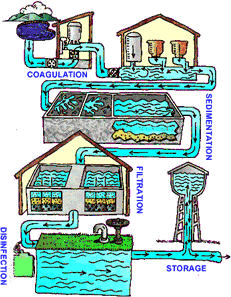Water Treatment
Community Water Treatment
Drinking water supplies in the United States are among the safest in the world. However, even in the U.S., drinking water sources can become contaminated, causing sickness and disease from waterborne germs, such as Cryptosporidium, E. coli, Hepatitis A, Giardia intestinalis, and other pathogens.
Drinking water sources are subject to contamination and require appropriate treatment to remove disease-causing agents. Public drinking water systems use various methods of water treatment to provide safe drinking water for their communities. Today, the most common steps in water treatment used by community water systems (mainly surface water treatment) include:

Figure courtesy of EPA [View larger image]
- Coagulation and Flocculation
- Coagulation and flocculation are often the first steps in water treatment. Chemicals with a positive charge are added to the water. The positive charge of these chemicals neutralizes the negative charge of dirt and other dissolved particles in the water. When this occurs, the particles bind with the chemicals and form larger particles, called floc.
- Sedimentation
- During sedimentation, floc settles to the bottom of the water supply, due to its weight. This settling process is called sedimentation.
- Filtration
- Once the floc has settled to the bottom of the water supply, the clear water on top will pass through filters of varying compositions (sand, gravel, and charcoal) and pore sizes, in order to remove dissolved particles, such as dust, parasites, bacteria, viruses, and chemicals.
- Disinfection
- After the water has been filtered, a disinfectant (for example, chlorine, chloramine) is added in order to kill any remaining parasites, bacteria, and viruses.
Water may be treated differently in different communities depending on the quality of the water that enters the treatment plant. Typically, surface water requires more treatment and filtration than ground water because lakes, rivers, and streams contain more sediment and pollutants and are more likely to be contaminated than ground water.
Some water supplies may also contain disinfections by-products, inorganic chemicals, organic chemicals, and radionuclides. Specialized methods for controlling formation or removing them can also be part of water treatment. To learn more about the different treatments for drinking water, see the National Drinking Water Clearinghouse's Fact Sheet Series on Drinking Water Treatments.
To learn more about the steps that are taken to make our water safe to drink, visit the United States Environmental Protection Agency's (EPA) Public Drinking Water Systems webpage. To learn more about the 90+ contaminants EPA regulates and why, visit EPA's Drinking Water Contaminants page.
Water Fluoridation
Community water fluoridation prevents tooth decay safely and effectively. Water fluoridation has been named one of 10 great public health achievements of the 20th century (1). For more information on the fluoridation process and to find details on your water system's fluoridation, visit CDC's Community Water Fluoridation page.
Consumer Confidence Reports
Every community water supplier must provide an annual report, sometimes called a Consumer Confidence Report, or "CCR," to its customers. The report provides information on your local drinking water quality, including the water's source, contaminants found in the water, and how consumers can get involved in protecting drinking water.
- View the CDC's guide to Understanding Consumer Confidence Reports
- See if your CCR is posted online (United States Environmental Protection Agency Local Drinking Water Information)
Household Water Treatment
Even though EPA regulates and sets standards for public drinking water, many Americans use a home water treatment unit to:
- Remove specific contaminants
- Take extra precautions because a household member has a compromised immune system
- Improve the taste of drinking water
Household water treatment systems are composed of two categories: point-of-use and point-of-entry (NSF). Point-of-entry systems are typically installed after the water meter and treat most of the water entering a residence. Point-of-use systems are systems that treat water in batches and deliver water to a tap, such as a kitchen or bathroom sink or an auxiliary faucet mounted next to a tap.
The most common types of household water treatment systems consist of:
- Filtration Systems
- A water filter is a device which removes impurities from water by means of a physical barrier, chemical, and/or biological process.
- Water Softeners
- A water softener is a device that reduces the hardness of the water. A water softener typically uses sodium or potassium ions to replace calcium and magnesium ions, the ions that create “hardness.”
- Distillation Systems
- Distillation is a process in which impure water is boiled and the steam is collected and condensed in a separate container, leaving many of the solid contaminants behind.
- Disinfection
- Disinfection is a physical or chemical process in which pathogenic microorganisms are deactivated or killed. Examples of chemical disinfectants are chlorine, chlorine dioxide, and ozone. Examples of physical disinfectants include ultraviolet light, electronic radiation, and heat.
For more information on personal household water treatment options, visit:
- A Guide to Drinking Water Treatment Technologies for Household Use (CDC)
- Selecting a Household Water Treatment System (NSF International)
- Water & Health Series: Filtration Facts brochure (EPA) [PDF - 1.17 MB]
- Ten Great Public Health Achievements—United States, 1900–1999. MMWR, December 24, 1999;48(50):1141. Available at http://www.cdc.gov/mmwr/preview/mmwrhtml/mm4850bx.htm.
Get email updates
To receive email updates about this page, enter your email address:
Contact Us:
- Centers for Disease Control and Prevention
1600 Clifton Rd
Atlanta, GA 30333 - 800-CDC-INFO
(800-232-4636)
TTY: (888) 232-6348 - New Hours of Operation
8am-8pm ET/Monday-Friday
Closed Holidays - cdcinfo@cdc.gov


